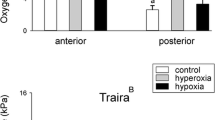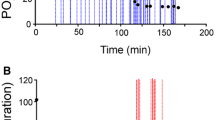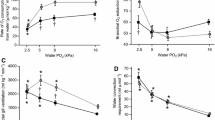Abstract
In the tropics, air-breathing fishes can be exposed to environmental ammonia when stranded in puddles of water during the dry season, during a stay inside a burrow, or after agricultural fertilization. At low concentrations of environmental ammonia, NH3 excretion is impeded, as in aerial exposure, leading to the accumulation of endogenous ammonia. At high concentrations of environmental ammonia, which results in a reversed NH3 partial pressure gradient (ΔPNH3), there is retention of endogenous ammonia and uptake of exogenous ammonia. In this review, several tropical air-breathing fishes (giant mudskipper, African catfish, oriental weatherloach, swamp eel, four-eyed sleeper, abehaze and slender African lungfish), which can tolerate high environmental ammonia exposure, are used as examples to demonstrate how eight different adaptations can be involved in defence against ammonia toxicity. Four of these adaptations deal with ammonia toxicity at branchial and/or epithelial surfaces: (1) active excretion of NH4+; (2) lowering of environmental pH; (3) low NH3 permeability of epithelial surfaces; and (4) volatilization of NH3, while another four adaptations ameliorate ammonia toxicity at the cellular and subcellular levels: (5) high tolerance of ammonia at the cellular and subcellular levels; (6) reduction in ammonia production; (7) glutamine synthesis; and (8) urea synthesis. The responses of tropical air-breathing fishes to high environmental ammonia are determined apparently by behavioural adaptations and the nature of their natural environments.
Similar content being viewed by others
Abbreviations
- CPS :
-
Carbamoyl phosphate synthetase
- FAA :
-
Free amino acids
- GDH :
-
Glutamate dehydrogenase
- GS :
-
Glutamine synthetase
- HEA :
-
High concentrations of environmental ammonia
- α-KG :
-
α-ketoglutarate
- N :
-
Nitrogen
- NHE :
-
Na+/H+ exchanger
- OUC :
-
Ornithine-urea cycle
- ΔP NH3 :
-
NH3 Partial pressure gradient
- pH env :
-
Environmental pH
- TEP :
-
Transepithelial potential
References
Anderson PM (2001) Urea and glutamine synthesis: Environmental influences on nitrogen excretion. In: Wright PA, Anderson PM (eds) Fish physiology, vol 20. Nitrogen excretion. Academic Press, New York, pp 239–277
Anderson PM, Broderius MA, Fong KC, Tsui KNT, Chew SF, Ip YK (2002) Glutamine synthetase expression in liver, muscle, stomach and intestine of Bostrichyths sinensis in response to exposure to a high exogenous ammonia concentration. J Exp Biol 205:2053–2065
Arillo A, Margiocco C, Melodia F, Mensi P, Schenone G (1981) Ammonia toxicity mechanisms in fish: studies on rainbow trout (Salmo gairdneri Rich). Ecotoxicol Environ Saf 5:316–325
Avella M, Bornancin M (1989) A new analysis of ammonia and sodium transport through the gills of the freshwater rainbow trout (Salmo gairdneri). J Exp Biol 142:155–175
Binstock L, Lecar H (1969) Ammonium ion currents in the squid giant axon. J Gen Physiol 53:342–361
Brusilow SW (2002) Reviews in molecular medicine—hyperammonemic encephalopathy. Medicine 81:240–249
Campbell JW (1973) Nitrogen excretion. In: Prosser CL (ed) Comparative animal physiology, 3rd edn. Saunders, Philadelphia, pp 279–316
Chang A, Hammond TG, Sun TT, Zeidel ML (1994) Permeability properties of the mammalian bladder apical membrane. Am J Physiol 267:1483–1492
Chew SF, Jin Y, Ip YK (2001) The loach Misgurnus anguillicaudatus reduces amino acid catabolism and accumulates alanine and glutamine during aerial exposure. Physiol Biochem Zool 74:226–237
Chew SF, Hong LN, Wilson JM, Randall DJ, Ip YK (2003a) Alkaline environmental pH has no effect on the excretion of ammonia in the mudskipper Periophthalmodon schlosseri but inhibits ammonia excretion in the related species Boleophthalmus boddaerti. Physiol Biochem Zool 76:204–214
Chew SF, Ong TF, Ho L, Tam WL, Loong AM, Hiong KC, Wong WP, Ip YK (2003b) Urea synthesis in the African lungfish Protopterus dolloi—hepatic carbamoyl phosphate synthetase III and glutamine synthetase are up-regulated by 6 days of aerial exposure. J Exp Biol 206:3615–3624
Chew SF, Wong MY, Tam WL, Ip YK (2003c) The snakehead Channa asiatica accumulates alanine during aerial exposure, but is incapable of sustaining locomotory activities on land through partial amino acid catabolism. J Exp Biol 206:693–704
Chew SF, Ho L, Ong TF, Wong WP, Ip YK (2004a) The African lungfish, Protopterus dolloi, detoxifies ammonia to urea during environmental ammonia exposure. Physiol Biochem Zool (in press)
Chew SF, Wilson JM, Ip YK, Randall DJ (2004b) Nitrogen excretion and defense against ammonia toxicity. In: Val A, Almedia-Val V, Randall DJ (eds) Fish physiology, vol 23. The physiology of tropical fishes. Academic Press, New York (in press)
Clayton DA (1993) Mudskippers. Oceanogr Mar Biol Annu Rev 31:507–577
Cooper JL, Plum F (1987) Biochemistry and physiology of brain ammonia. Physiol Rev 67:440–519
Daoust PY, Ferguson HW (1984) The pathology of chronic ammonia toxicity in rainbow trout, Salmo gairdneri Richardson. J Fish Dis 7:199–205
Davenport J, Sayer MDJ (1986) Ammonia and urea excretion in the amphibious teleost Blennius pholis (L.) in seawater and in air. Comp Biochem Physiol 84A:189–194
Davidson A (1975) Fish and fish dishes of Laos. Imprimerie Nationale, Vientiane, p 202
Deare FM, Ahmad N, Ferguson TU (1995) Downward movement of nitrate and ammonium nitrogen in a flatland ultisol. Fertilizer Res 42:175–184
Eddy FB, Bamford OS, Maloiy GMO (1980) Sodium and chloride balance in the African catfish Clarias mossambicus. Comp Biochem Physiol 66A:637–641
Evans DH, Cameron JN (1986) Gill ammonia transport. J Exp Zool 239:17–23
Felipo V, Butterworth RF (2002) Neurobiology of ammonia. Progr Neurobiol 67:259–279
Felipo V, Kosenko E, Minana MD, Marcaida G, Grisolia S (1994) Molecular mechanism of acute ammonia toxicity and of its prevention by l-carnitine. In: Felipo V, Grisola S (eds) Hepatic encephalopathy, hyperammonemia and ammonia toxicity. Plenum, New York, pp 65–77
Ferguson HW, Morrison D, Ostland VE, Lumsden J, Byrne P (1992) Responses of mucus-producing cells in gill disease of rainbow trout (Oncorhynchus mykiss). J Comp Pathol 106:255–265
Freney JR, Denmead OT, Watanabe I, Craswell ET (1981) Ammonia and nitrous oxide losses following applications of ammonium sulfate to flooded rice. Aust J Agric Res 32:37–45
Frick NT, Wright PA (2002) Nitrogen metabolism and excretion in the mangrove killifish Rivulus marmoratus II. Significant ammonia volatilization in a teleost during air-exposure. J Exp Biol 205:91–100
Gonzalez RJ, McDonald DG (1994) The relationship between oxygen uptake and ion loss in fish from diverse habitats. J Exp Biol 190:95–108
Goss GG, Wood CM (1990) Na + and Cl− uptake kinetics, diffusive effluxes and acidic equivalent fluxes across the gills of rainbow trout I. Response to environmental hyperoxia. J Exp Biol 152:521–547
Graham JB (1997) Air-breathing fishes. Academic Press, San Diego, 299 pp
Hazel JR, Landrey SR (1988) The course of thermal adaptation in plasma membranes of trout kidney. I. Headgroup composition. Am J Physiol 255:R622-R627
Hazel JR. Williams EE (1990) The role of alteration in membrane lipid composition in enabling physiological adaptation of organisms to their physical environment. Progr Lipid Res 29:167–227
Hermenegildo C, Monfor CP, Felipo V (2000) Activation of N-methyl-d-aspartate receptors in rate brain in vivo following acute ammonia intoxication: characterization by in vivo brain microdialysis. Hepatology 31:709–715
Ip YK, Lee CY, Chew SF, Low WP, Peng K W (1993) Differences in the responses of two mudskippers to terrestrial exposure. Zool Sci 10:511–519
Ip YK, Chew SF, Randall D J (2001a) Ammonia toxicity, tolerance, and excretion. In: Wright PA, Anderson PM (eds) Fish physiology, vol 20. Nitrogen excretion. Academic Press, San Diego pp 109–148
Ip YK, Chew SF, Leong IWA, Jin Y, Wu RSS (2001b) The sleeper Bostrichthys sinensis (teleost) stores glutamine and reduces ammonia production during aerial exposure. J Comp Physiol B 171:357–367
Ip YK, Randall DJ, Kok TKT, Bazarghi C, Wright PA, Ballantyne JS, Wilson JM, Chew SF (2003a) The mudskipper Periophthalmodon schlosseri facilitates active NH4+ excretion by increasing acid excretion and decreasing NH3 permeability in the skin. J Exp Biol 207:787–801
Ip YK, Tam WL, Wong WP, Loong AI, Hiong KC, Ballantyne JS, Chew SF (2003b) A comparison of the effects of environmental ammonia exposure on the Asian freshwater stingray Himantura signifier and the Amazonian freshwater stingray Potamotrygon motoro. J Exp Biol 206:3625–3633
Ip YK, Subaidah RM, Liew PC, Loong AM, Hiong KC, Wong WP, Chew SF (2004a) The African catfish Clarias gariepinus does not detoxify ammonia to urea or amino acids during ammonia loading but is capable of excreting ammonia against an inwardly driven ammonia concentration gradient. Physiol Biochem Zool 77:242–254
Ip YK, Tay ASL, Lee KH, Chew SF (2004b) Strategies adopted by the swamp eel Monopterus albus to survive in high concentrations of environmental ammonia. Physiol Biochem Zool (in press)
Ip YK, Chew SF, Randall DJ (2004c) Five tropical fishes, six different strategies to defend against ammonia toxicity on land. Physiol Biochem Zool (in press)
Iwata K (1988) Nitrogen metabolism in the mudskipper, Periophthalmus cantonensis: changes in free amino acids and related compounds in carious tissues under conditions of ammonia loading with reference to its high ammonia tolerance. Comp Biochem Physiol 91A:499–508
Iwata K, Deguichi M (1995) Metabolic fate and distribution of 15N-ammonia in an ammonotelic amphibious fish, Periophthalmus modestus, following immersion in 15N-ammonium sulphate: a long-term experiment. Zool Sci 12:175–184
Iwata K, Kajimura M, Sakamoto T (2000) Functional ureogenesis in the gobiid fish Mugilogobius abei. J Exp Biol 203:3703–3715
Iwata K, Kakuta M, Ikeda G, Kimoto S, Wada N (1981) Nitrogen metabolism in the mudskipper, Periophthalmus cantonensis: a role of free amino acids in detoxification of ammonia produced during its terrestrial life. Comp Biochem Physiol 68A:589–596
Jow LY, Chew SF, Lim CB, Anderson PM, Ip YK (1999) The marble goby Oxyeleotris marmoratus activated hepatic glutamine synthetase and detoxifies ammonia to glutamine during air exposure. J Exp Biol 202:237–245
Kikeri D, Sun A, Zeidel ML, Hebert SC (1989) Cell membranes impermeable to NH3. Nature 339:478–480
Kok WK, Lim CB, Lam TJ, Ip YK (1998) The mudskipper Periophthalmodon schlosseri respires more efficiently on land than in water and vice versa for Boleophthalmus boddaerti. J Exp Zool 280:86–90
Korsgaard B, Mommsen TP, Wright PA (1995) Urea excretion in teleostean fishes: adaptive relationships to environment, ontogenesis and viviparity. In: Walsh PJ, Wright PA (eds) Nitrogen metabolism and excretion. CRC Press, Boca Raton, pp 259–287
Lande MB, Donovan JM, Zeidel ML (1995) The relationship between membrane fluidity and permeabilities to water, solute, ammonia, and protons. J Gen Physiol 106:67–84
Levi G, Morisi G, Coletti A, Catanzaro R (1974) Free amino acids in fish brain: normal levels and changes upon exposure to high ammonia concentrations in vivo and upon incubation of brain slices. Comp Biochem Physiol 49A:623–636
Liem KE (1987) Functional design of the air ventilation apparatus and overland excursions by teleosts. Fieldiana: Zoology 37:1–29
Lim CB, Chew SF, Anderson PM, Ip YK (2001) Mudskippers reduce the rate of protein and amino acid catabolism in response to terrestrial exposure. J Exp Biol 204:1605–1614
Low WP, Ip YK, Lane DJW (1990) A comparative study of the gill morphometry in three mudskippers—Periophthalmus chrysospilos, Boleophthalmus boddaerti and Periophthalmodon schlosseri. Zool Sci 7:29–38
Low WP, Lane DJW, Ip YK (1988) A comparative study of terrestrial adaptations in three mudskippers—Periophthalmus chrysospilos, Boleophthalmus boddaerti and Periophthalmodon schlosseri. Biol Bull 175:434–438
Madara JL (1998) Regulation of the movement of solutes across tight junctions. Annu Rev Physiol 60:143–159
Maetz J (1973) Na+/NH4+, Na+/H+ exchanges and NH3 movement across the gill of Carassius auratus. J Exp Biol 58:255–273
Maetz J, Garcia-Romeu F (1964) The mechanisms of sodium and chloride uptake by the gills of a freshwater fish, Carassius auratus. II. Evidence for NH4+/Na+ and HCO3−/Cl− exchanges. J Gen Physiol 47:1209–1227
Marcaggi P, Coles, JA (2001) Ammonium in nervous tissues: transport across cell membranes, fluxes from neurons to glial cells, and role in signaling. Progr Neurobiol.64:157–183
McMahon BR, Burggren WW (1987) Respiratory physiology of intestinal air breathing in the teleost fish Misgurnus anguillicaudatus. J Exp Biol 133:371–393
Nakhoul NL, Hering-Smith KS, Abdulnour-Nakhoul SM, Hamm LL (2001) Transport of NH3/NH4+ in oocytes expressing aquaporin-1. Am J Physiol 281:F255–F263
Oellermann LK (1995) A comparison of the aquaculture potential of Clarius gariepinus (Burchell, 1922) and its hybrid with Heterobranchus longifilis (Valenciennes, 1840) in southern Africa. PhD Thesis, Rhodes University, Grahamstown, South Africa
Peng KW, Chew SF, Lim CB, Kuah SSL, Kok WK, Ip YK (1998) The mudskippers Periophthalmodon schlosseri and Boleophthalmus boddaerti can tolerate environmental NH3 concentrations of 446 and 36 μM, respectively. Fish Physiol Biochem 19:59–69
Poll M (1961) Révision systématique et raciation géographique des Protopteridae de l’Afrique centrale. Ann Mus R Afr Centr, série in-8o, Sci Zool 103:3–50
Rainboth WJ (1996) Fishes of the Cambodian Mekong. FAO Species Identification Field Guide for Fishery Purposes. FAO, Rome, p 265
Randall DJ, Wilson JM, Peng KW, Kok TWK, Kuah SSL, Chew SF, Lam TJ, Ip YK (1999) The mudskipper, Periophthalmodon schlosseri, actively transports NH4+ against a concentration gradient. Am J Physiol 277:R1562–R1567
Randall DJ, Wood CM, Perry SF Bergman H, Maloiy GM, Mommsen TP, Wright PA (1989) Urea excretion as a strategy for survival in a fish living in a very alkaline environment. Nature 337:165–166
Rose C (2002) Increased extracellular brain glutamate in acute liver failure: decreased uptake or increased release? Met Brain Dis 17:251–261
Rozemeijer MJC, Plaut, I (1993) Regulation of nitrogen excretion of the amphibious blenniidae Alticus kirki (Guenther, 1868) during emersion and immersion. Comp Biochem Physiol 104A:57–62
Saha N, Ratha BK (1998) Ureogenesis in Indian air-breathing teleosts: adaptation to environmental constraints. Comp Biochem Phsyiol 120A:195–208
Singh SK, Binder HJ, Geibel JP, Boron WF 1995. An apical permeability barrier to NH3/NH4+ in isolated, perfused colonic crypts. Proc Natl Acad Sci USA 92:11573–11577
Smart GR (1976) The effect of ammonia exposure on gill structure of the rainbow trout (Salmo gairdneri). J Fish Biol 8:471–475
Smart GR (1978) Investigations of the toxic mechanisms of ammonia to fish-gas exchange in rainbow trout (Salmo gairdneri) exposed to acutely lethal concentrations. J Fish Biol 12:93–104
Steward PA (1983) Modern quantitative acid-base chemistry. Can J Physiol Pharmacol 61:1444–1461
Tay SLA, Chew SF, Ip YK (2003) The swamp eel Monopterus albus reduces endogenous ammonia production and detoxifies ammonia to glutamine during aerial exposure. J Exp Biol 206:2931–3940
Tsui TKN, Randall DJ, Chew SF, Jin Y, Wilson JM, Ip YK (2002) Accumulation of ammonia in the body and NH3 volatilization from alkaline regions of the body surface during ammonia loading and exposure to air in the weather loach Misgurnus anguillicaudatus. J Exp Biol 205:651–659
Twitchen ID, Eddy FB (1994) Effects of ammonia on sodium balance in juvenile rainbow trout Oncorhynchus mykiss Walbaum. Aqua Toxicol 30:27–45
Walsh PJ, Danulat E, Mommsen TP (1990) Variation in urea excretion in the gulf toadfish (Opsanus beta). Mar Biol 106:323–328
Walton MJ, Cowey CB (1977) Aspects of ammoniagenesis in rainbow trout, Salmo gairdneri. Comp Biochem Physiol 57:143–149
Wilkie MP (1997) Mechanisms of ammonia excretion across fish gills. Comp Biochem Physiol 118A:39–50
Wilson JM, Randall DJ, Donowitz M, Vogl AW, Ip YK (2000) Immunolocalization of ion-transport proteins to branchial epithelium mitochondria-rich cells in the mudskipper (Periophthalmodon schlosseri). J Exp Biol 203:2297–2310
Wilson JM, Randall DJ, Kok TWK, Vogl WA, IpYK (1999) Fine structure of the gill epithelium of the terrestrial mudskipper, Periophthalmodon schlosseri. Cell Tissue Res 298:345–356
Wilson RW, Wright PA, Munger S, Wood CM (1994) Ammonia excretion in freshwater rainbow trout (Oncorhynchus mykiss) and the importance of gill boundary layer acidification: lack of evidence for Na+-NH4+ exchange. J Exp Biol 191:37–58
Wright PA, Land MD (1998) Urea production and transport in teleost fishes. Comp Biochem Physiol 119A:47–54
Author information
Authors and Affiliations
Corresponding author
Additional information
Communicated by I.D. Hume
Rights and permissions
About this article
Cite this article
Ip, Y.K., Chew, S.F., Wilson, J.M. et al. Defences against ammonia toxicity in tropical air-breathing fishes exposed to high concentrations of environmental ammonia: a review. J Comp Physiol B 174, 565–575 (2004). https://doi.org/10.1007/s00360-004-0445-1
Accepted:
Published:
Issue Date:
DOI: https://doi.org/10.1007/s00360-004-0445-1




